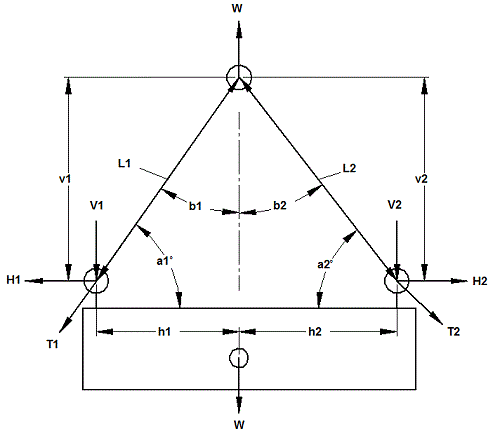Lifting Sling Load Equations and Calculator
Mechanics and Machines Calculations Menu
Application of Slings for lifting considerations and sling lifting load calculations (bottom).
Slings should have a minimum design factor appropriate to the type of material asspecified in the appropriate section.Features that affect the rated capacity of the sling and that shall be considered in calculating the design factor are:
-
Nominal breaking strength of material from which it is constructed.
-
Splicing or end-attachment.
-
Number of parts in the sling.
-
Type of hitch (e.g., straight pull, choker hitch, or basket hitch).
-
Angle of loading and load center of gravity.
-
In general, slings angles a1 and a2 (see graphic below) should not be < 30° . Check manufacturer of sling fro approved angle ranges.
-
Diameter of curvature around which the sling is bent.
- The center of gravity of an object is a point around which the entire weight may be concentrated. To make a level lift, the crane hook or point of suspension must be directly above this point. While slight variations are usually permissible, if the crane hook is too far to one side of the center of gravity, dangerous tilting will result and should be corrected at once. For this reason, when the center of gravity is closer to one point of the sling attachment than to the other, the slings must be of unequal length. Sling stresses and sling angles will also be unequal.
- . Rigging shall be configured such that slings do not reeve or slip through the hook. To attach the load, locate the center of gravity, position the crane hook directly above the center of gravity, and then rig the load so that it will lift level and true.
Tension on Sling T(1, 2) = ( V12 + H12 )(1/2)
Tension on Sling T(1, 2) = W / ( # legs sin(a1, 2))
Tension on Sling T(1, 2) = ( L1, 2 / v1, 2 ) ( W / 2 )
*** Units - keep input consistant
Use in. with lbs and mm with N
Reference:
Introduction to Sling Load Tension Calculations
Lecture Notes
Preparation for the Certified Safety Professional Examinations
Dr. Mitch Ricketts
Northeastern State University at Broken arrow
Sources for Further Study:
Occupational Safety and Health Administration (OSHA). (n.d.).
Guidance on sling use. Washington, DC: Author. Bechtel Corporation. (2002).
Bechtel rigging handbook (2nd ed.). San Francisco: Author. Yates, W. D. (2011).
Safety professional’s reference and study guide. Boca Raton, FL: CRC Press. Young, G. (Ed.). (2010).
Applied mathematics for safety professionals. Des Plaines, IL: American Society of Safety Professionals.
